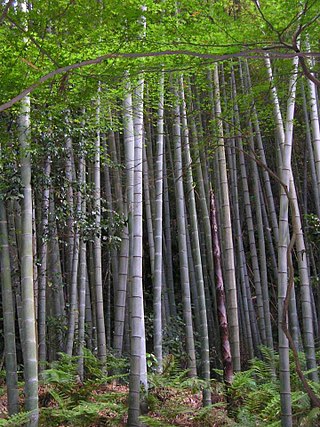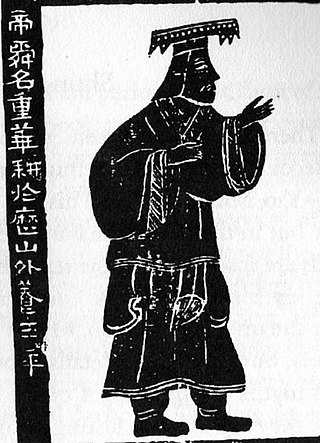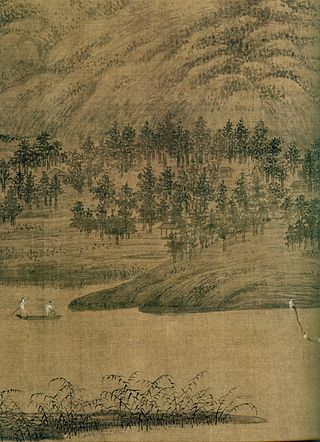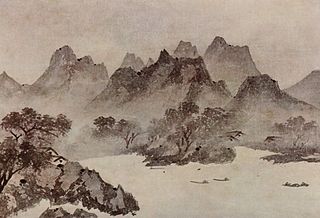
Bamboos are a diverse group of mostly evergreen perennial flowering plants making up the subfamily Bambusoideae of the grass family Poaceae. Giant bamboos are the largest members of the grass family, in the case of Dendrocalamus sinicus individual culms reaching a length of 46 meters, up to 36 centimeters in thickness and a weight of up to 450 kilograms. The internodes of bamboos can also be of great length. Kinabaluchloa wrayi has internodes up to 2.5 meters in length. and Arthrostylidium schombergkii with lower internodes up to 5 meters in length, exceeded in length only by papyrus. By contrast, the culms of the tiny bamboo Raddiella vanessiae of the savannas of French Guiana are only 10–20 millimeters in length by about two millimeters in width. The origin of the word "bamboo" is uncertain, but it probably comes from the Dutch or Portuguese language, which originally borrowed it from Malay or Kannada.

The Qianlong Emperor, also known by his temple name Emperor Gaozong of Qing, personal name Hongli, was the fifth emperor of the Qing and the fourth Qing emperor to rule over China proper. The fourth son of the Yongzheng Emperor, he reigned officially from 11 October 1735 to 8 February 1796. In 1796, he abdicated in favour of his son, the Jiaqing Emperor, out of filial piety towards his grandfather, the Kangxi Emperor, who ruled for 61 years, so that he not officially usurp him as the longest-reigning emperor. Despite his retirement, however, the Qianlong Emperor retained ultimate power as the Emperor Emeritus until his death in 1799, making him one of the longest-reigning monarchs in history as well as one of the longest-lived, having died at the age of 87. He was respected as the "Emperor Manjushri" (文殊皇帝) by Tibetans.

Dongting Lake is a large, shallow lake in northeastern Hunan Province, China. It is a flood basin of the Yangtze River, so its volume depends on the season. The provinces of Hubei and Hunan are named after their location relative to the lake: Hubei means "North of the Lake" and Hunan, "South of the Lake".

The Xiang River is the chief river of the Lake Dongting drainage system of the middle Yangtze, the largest river in Hunan Province, China. It is the 2nd largest tributary in terms of surface runoff, the 5th largest tributary by drainage area of the Yangtze tributaries. The river flows generally northeast through the provinces of Guangxi and Hunan, its tributaries reaching into Jiangxi and Guangdong.

The Chenghua Emperor, also known by his temple name as the Emperor Xianzong of Ming, personal name Zhu Jianshen (朱見深), changed to Zhu Jianru (朱見濡) in 1457, was the ninth emperor of the Ming dynasty, who reigned from 1464 to 1487. He succeeded his father, Emperor Yingzong. "Chenghua", the era name of his reign, literally means "accomplished change".

Zongzi, rouzong, or simply zong is a traditional Chinese rice dish made of glutinous rice stuffed with different fillings and wrapped in bamboo leaves, or sometimes with reed or other large flat leaves. They are cooked by steaming or boiling. People in the Eastern world often translate this dish into English as rice dumplings or sticky rice dumplings.

Emperor Shun was a legendary leader of ancient China, regarded by some sources as one of the Three Sovereigns and Five Emperors being the last of the Five Emperors. Tradition holds that he lived sometime between 2294 and 2184 BC. Tradition also holds that those with surname Chen (陳) are descendants of Emperor Shun. The Duke Hu of Chen, a descendant of Shun, became the founder of the State of Chen. Later Chen dynasty emperors such as Chen Baxian would also claim descent from Shun.

Dong Yuan was a Chinese painter.

Huang Tingjian was a Chinese calligrapher, painter, and poet of the Song dynasty. He is predominantly known as a calligrapher, and is also admired for his painting and poetry. He was one of the Four Masters of the Song Dynasty, and was a younger friend of Su Shi and influenced by his and his friends' practice of literati painting, calligraphy, and poetry; regarded as the founder of the Jiangxi school of poetry.

Junshan Island is an island in Hunan province in China on Dongting Lake. The name derives from the legend of the Xiang River goddesses. It is 0.96 km2 (0.37 sq mi) in area. It was formerly a Daoist retreat.

The Eight Views of Xiaoxiang are scenes of the Xiaoxiang region, in what is now modern Hunan Province, China, that were the subject of the poems and depicted in well-known drawings and paintings from the time of the Song Dynasty. The Eight Views of Xiaoxiang can refer either to various sets of paintings which have been done on this theme, the various verse series on the same theme, or to combinations of both. The Xiaoxiang theme is part of a long poetic and artistic legacy.
Song poetry refers to Classical Chinese poetry of or typical of the Song dynasty of China, established by the Zhao family in China in 960 and lasted until 1279.

Xiaoxiang, also transliterated XiaoXiang, Hsiao Hsiang, and Chiu Chiang, in some older sources, refers to the "lakes and rivers" region in south-central China south of the middle-reaches of the Yangtze River and corresponding, more or less, with Hunan province. Xiaoxiang is less a precise geographic entity than a concept. Xiaoxiang is used in the genre of Xiaoxiang poetry of Classical Chinese poetry and in literature for symbolic purposes, in part because this was a significant area, which at least through the Song dynastic era China was still considered a wild place full of malaria, barbarians, and wild beasts. Indeed, for much of early Chinese history, this area belonged not to China, but to the independent state of Chu. Beginning at least with Qu Yuan, in the third century BCE, this region came to symbolically represent the unjust exile of a talented minister or government official by an unappreciative king or emperor.

The Xiangshuishen or Xiang River Goddesses are goddesses of the Xiang River in Chinese folk religion. The Xiang flowed into Dongting Lake through the ancient kingdom of Chu, whose songs in their worship have been recorded in a work attributed to Qu Yuan. According to the Shanhaijing, the Xiang River deities were daughters of the supreme deity, Di. According to a somewhat later tradition, the Xiang goddesses were daughters of Emperor Yao, who were named Ehuang and Nüying who were said to have been married by him to his chosen successor, and eventually emperor, Shun, as a sort of test of his administrative abilities: then, later, they became goddesses, after the death of their husband.

An oil-paper umbrella is a type of paper umbrella that originated in China. It subsequently spread across several East, South and Southeast Asian countries such as Japan, Korea, Malaysia, Myanmar, Bangladesh, India, Sri Lanka, Thailand, Laos and Vietnam, where it has been further developed with different characteristics.

Xiaoxiang poetry is one of the Classical Chinese poetry genres, one which has been practiced for over a thousand years. It is a poetry of scenic wonders, a poetry of officials exiled for their views and beliefs, and a poetry of dissent against submitting to government control. Xiaoxiang poetry is geographically associated with the Xiaoxiang region, around and south of Dongting Lake. The Xiaoxiang genre of literature is often associated with similarly themed Chinese calligraphy and Chinese painting. Famous poets in this genre include Qu Yuan, Song Yu, Jia Yi, Wang Yi, Yu Xin, Shen Quanqi, Zhang Yue, Li Bai, Du Fu, Han Yu, Liu Zongyuan, and Su Shi.

Simians of various sorts are an important motif in Chinese poetry. Examples of simian imagery have an important place in Chinese poetry ranging from the Chu Ci poets through poets such as Li Bai, Wang Wei, Du Fu, and more. Various poetic concepts could be communicated by the inclusion of simian imagery in a poem, and the use of simian allusions can help provide key insights into the poems. The use of simians in Chinese poetry is part of a broader appearance of macaques and other monkeys in Chinese culture as well as the monkey-like gibbons and sometimes monkey-like creatures from Chinese mythology.
Ma Shouzhen, also known by her courtesy name Ma Xianglan and pen name Yuejiao, was a Chinese courtesan and artist born in Nanjing during the late Ming dynasty (1550–1644). She was a renowned painter, poet, and composer. She received the name Xianglan because her most favored paintings were of orchids.

The culture of Hunan (湖湘文化) refers to the culture of the people based in the Hunan province of China. The mountainous terrain of Hunan separates it from the surrounding Chinese provinces, resulting in its own distinct characteristics. As the Xiang River runs through the province from south to north, Hunan is called "Xiang" for short and boasts its "Xiang Cuisine", "Xiang Embroidery", "Xiang Opera", and "Xiang Army". Therefore, the culture of Hunan is also called the Huxiang culture. The culture of Hunan is originated in Chu (state) culture from the Zhou dynasty. The meaning of Hunan culture contains two aspects. Generally speaking, it refers to the sum of folk customs, social consciousness, scientific culture, and material culture that have been created in the long-term history of people of all ethnic groups in Hunan. In a narrow sense, it refers to the spirit that developed and accumulated on this basis.

The Eight Beauties of Qinhuai, also called the Eight Beauties of Jinling, were eight famous Yiji or Geji during the Ming-Qing transition period who resided along the Qinhuai River in Nankin. As well as possessing great beauty, they were all skilled in literature, poetry, fine arts, dancing and music.

















